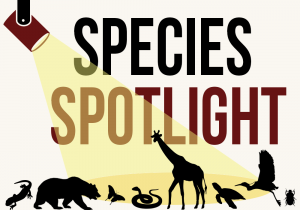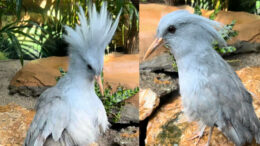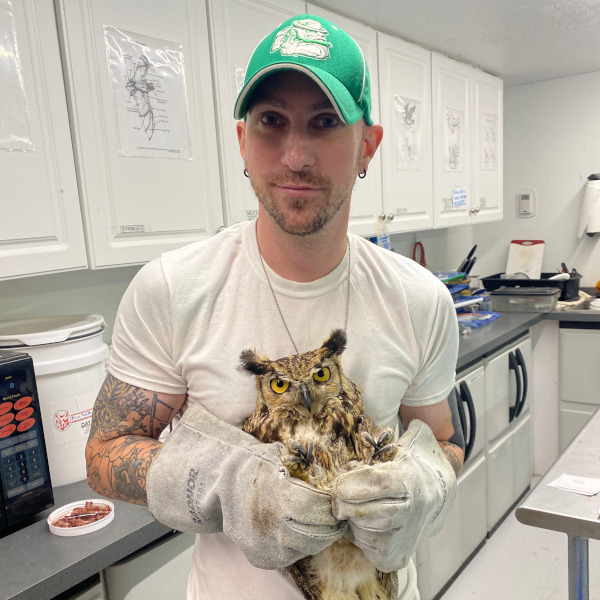 Known as the “Ghosts of the Forest” due to their pale color and ghostly cries, the elusive and endangered kagu of New Caledonia are haunted by the apparitions of human interference, invasive predators, and habitat destruction as the past transgressions of humans threaten to erase them from the land of the living.
Known as the “Ghosts of the Forest” due to their pale color and ghostly cries, the elusive and endangered kagu of New Caledonia are haunted by the apparitions of human interference, invasive predators, and habitat destruction as the past transgressions of humans threaten to erase them from the land of the living.
Species Name:
Kagu or cagou (Rhynochetos jubatus)
Description:
Nearly flightless, the kagu is a large, ground-dwelling bird with whiteish- or blueish-gray feathers, dark bands on its primaries, and bright-red legs and beak. Adults stand around 22 inches in height and have a wingspan up to 32 inches, while their weight ranges between 1.5 to 2.5 pounds depending on the season. Adorned with a long, heron-like beak, erectile crest, and covered in a powdered down to protect them from rain and extreme temperatures, they are the only known bird species to have nasal corns — thick skin flaps that protect their nostrils as they root around in the soil for small insects to eat. Their only known living relative are the sunbitterns of South and Central America.
Where It’s Found:
Kagu are endemic to the dense mountain forests and shrub lands of New Caledonia. Among that island chain, they are found only on the main island of Grande Terre. If sufficient prey is available, kagu can thrive in environments ranging from rainforests to dry lowland forests. They have even been known to survive in the drier shrublands associated with New Caledonia’s ultramafic rocks.
View this post on Instagram
Major Threats:
Because kagu are restricted to such a small and isolated geographic range, they’re more susceptible to threats and less resilient to population declines than other species who live on the mainland.
Discovered by Europeans in 1852, when the French colonized New Caledonia, the first kagu was described as a specimen when a live bird was brought to the Colonial Exhibition in Paris in 1860. The scientific intrigue that followed resulted in hundreds of birds being trapped and shipped off for display to zoos and museums around the world. To go along with this trapping, the colonizers began to find other uses for kagu. They became a local delicacy and cherished pets due to their beauty and personable behavior. Locals also prized their ghostly gray feathers, which they used for fashionable women’s hats in the 1900s, leading to even further declines of the wild population.
Along with these threats, the French also brought invasive mammal species to Grande Terre in the form of pigs, rats, cats and dogs. Before these animals arrived, the only mammals on the island were bats, and the kagu lived with no natural predators. But once these voracious animals arrived, they decimated the kagu population. Pigs and rats were observed raiding the ground-dwelling kagu nests and consuming their eggs (kagu only lay a single egg per season), while cats and dogs preyed on both young and adult kagu. Rats alone were responsible for over 50% of nestling losses.
These invasive mammals nearly caused the outright extinction of the species in 2017, when two stray dogs entered the Parc des Grandes Fougeres wildlife refuge of New Caledonia and went on an unparalleled killing spree. This catastrophic event lasted over two months, resulting in the deaths of over half of all radio-tagged individuals in the park and more than 75% of kagu families being destroyed.
Today the kagu face a new threat in the form of habitat loss due to the urbanization of New Caledonia’s forests and wetlands. Activities such as mining, agriculture, and logging have resulted in a significant loss of suitable habitats for the kagu, leaving less than half of the island’s rainforest untouched and safe for foraging and nesting.
IUCN Red List Status:
Once listed as “critically endangered” by the International Union for Conservation of Nature (IUCN) when the wild population was estimated at under 1,000 birds, the kagu’s conservation status has since been updated to “endangered” with a current estimation of fewer than 2,000 individuals in the wild.
Notable Conservation Programs or Legal Protections:
Due to its relative anonymity outside dedicated wildlife circles and a lack of detailed studies, conservation efforts for the kagu have progressed slowly since concern about its population first arose in 1904. But noticeable positive impacts on wild populations are finally being seen.
The attempt made to protect this species ran from 1977 to 1982; a campaign to phase out the kagu pet trade was initiated by the New Caledonian government, and successful captive breeding and reintroduction efforts began in 1978. Now the kagu is recognized as the national bird of New Caledonia and is afforded its full protection.
View this post on Instagram
From 2009 to 2020, a Kagu Species Action Plan was compiled to further protect the species, encompassing the wildlife reserves of Parc des Grandes Fougere, Pac Provincial Riviere Blue, and Reserve Speciale de Faune et de Flore de la Nodela. These reserves have been successfully tagging, breeding, and releasing kagu since 2011. Despite being protected reserves, the occasional deaths by invasive wildlife still happen within these parks. Only Riviere Bleue enjoys the additional benefit of being a dog-controlled area. Current legislations and educational programs are in place to limit incidental captures or killings caused by hunting dogs. To assist in these legislations, a pilot study began in 2013 to study wandering dog tribes in Massif des Levres.
Many zoos around the world — such as the Toledo Zoo and Aquarium and the world-famous San Diego Zoo — are doing their part to help save the kagu by engaging in carefully monitored breeding programs. San Diego Zoo Global has taken things a step further by compiling a highly detailed database of kagu DNA, in cooperation with the New Caledonia government, to help keep the captive kagu population diverse and prevent unwanted inbreeding.
In addition to captive-breeding and reintroduction programs, predator mitigation, and dog ownership education, recent conservation efforts center on habitat restoration, replanting of native trees, and strictly monitoring mining operations to prevent further destruction, but there’s still a long way to go before the kagu can rest easy.
My Favorite Experience:
As a bird keeper at the Toledo Zoo and Aquarium, I had the immense pleasure of working closely with our mated pair of kagu, whom I named Alfred and Ethel. It was a daunting task at first as I’d never seen, or even heard of, kagu before. Here I was, stepping in the open aviary with them after just two days of training, suddenly in charge of caring for these highly endangered birds: monitoring their breeding behaviors, recording their weights and diets, and making sure they stayed as healthy as possible.
It didn’t help that Alfred was highly territorial and liked to sneak up and jab at your legs with his incredibly sharp beak to let you know he was boss, making it difficult to do routine work inside the aviary.
Instead of being intimidated by his territorial nature, as some of the other keepers were, I decided to make friends with him in hopes that he would feel more at ease with my presence and his surroundings, improving the chance of successful breeding. This process started out slowly, with me bringing worms (his and Ethel’s favorite snack) with me every time I entered the aviary and tossing them on the ground while I went about cleaning the enclosure. This routine produced surprisingly good results, and our relationship quickly improved.
Once Alfred and Ethel realized I’d bring worms for them every time I came into the aviary, they began to wait for me just inside the door each morning and would follow me around until I gave them what they wanted. Ethel was the shier of the two and would usually only take the worm after I stepped away; but with time she began to hover, like Alfred. With the birds’ focus on the yummy treats, I used the worms to train the kagu for checkups, placing the worms by the scale so they’d step onto it without having to be restrained and stressed. I’d also use them to keep the birds in one place while I trimmed their nails and checked their feathers or as a distraction while I rearranged their enclosure to make it more like their natural habitat.
This routine went on for about a month — and then something amazing happened. One morning while I was cleaning the large pond in their enclosure, Alfred came up to watch what I was doing. This in itself was nothing new, since he was always curious, but this time he stood right up against my leg, leaning into it. He was willingly touching me without pecking me! Not wanting to ruin the moment or scare him, I slowly sat down at the edge of the pond while it filled and waited to see what he would do next. He did the same exact same thing, settling down right beside me and staring at me with his big black eyes. To see if he would let me, I reached out and gently scratched the top of his head. He froze, perhaps unsure how to react, but didn’t move away or try to peck at me. I kept scratching and talking quietly, and he started to make a soft cooing sound I’d never heard before from deep inside his chest. And as I slowly worked my way down toward his keel (a useful area to check to see if a bird is getting enough nourishment), Alfred began to lean into my scratches, his eyes closing. He was loving it.
From that day forward, Alfred and I developed a ritual each morning: He’d wait for me by the door, do what I needed him to do for training to get his worms, follow and stand next to me while I cleaned the aviary, and finally, settle beside me while I gave him some head and chest scratches as we waited for his pond to fill. It was a routine we both looked forward to and a memory I will carry with me forever.
What Else Do We Need to Understand or Do to Protect This Species?
There are a few things we can do to help continue the upward growth in kagu populations.
We should pay strict attention to population size, distribution, and behavioral trends, as well as evaluate the gene flow and fragmentation between subpopulations to eliminate inbreeding within territories and ensure a healthier, more successful gene pool.
Also, we should study the current effects and volume of rat predation on kagu nests to come up with a long-term solution, as well as perform further studies of dog groups within the island.
We can survey poorly known forest areas for habitat viability and restore deforested or mined areas so that released kagu have new, predator-free territories to breed in, or consider a reintroduction of the species on Panie Mountain or other islands within New Caledonia.
Last, we can continue to offer educational programs about the kagu, the dangers it faces, and what people can do to help, such as spaying and neutering their dogs and not allowing them to roam free.
Share your stories: Do you live in or near a threatened habitat or community, or have you worked to study or protect endangered wildlife? You’re invited to share your stories in our ongoing features, Protect This Place and Species Spotlight.
![]()
Previously in The Revelator:
Breeding the ‘Snot Otter’


